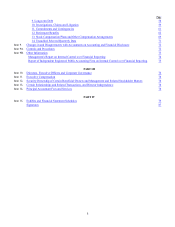Northrop Grumman 2014 Annual Report Download - page 14
Download and view the complete annual report
Please find page 14 of the 2014 Northrop Grumman annual report below. You can navigate through the pages in the report by either clicking on the pages listed below, or by using the keyword search tool below to find specific information within the annual report.NORTHROP GRUMMAN CORPORATION
-5-
COMPETITIVE CONDITIONS
We compete with many companies in the defense, intelligence and federal markets. BAE Systems, Boeing, Booz
Allen Hamilton, Finmeccanica, General Dynamics, L-3 Communications, Lockheed Martin, Raytheon and Thales
are some of our primary competitors. Key characteristics of our industry include long operating cycles and intense
competition, which is evident through the number of bid protests (competitor protests of U.S. Government
procurement awards) and the number of competitors bidding on program opportunities.
It is common in the defense industry for work on major programs to be shared among a number of companies. A
company competing to be a prime contractor may, upon ultimate award of the contract to another competitor,
become a subcontractor for the ultimate prime contracting company. It is not unusual to compete for a contract
award with a peer company and, simultaneously, perform as a supplier to or a customer of that same competitor on
other contracts, or vice versa.
SEASONALITY
No material portion of our business is considered to be seasonal.
BACKLOG
At December 31, 2014, total backlog was $38.2 billion, compared with $37.0 billion at the end of 2013. Of the
backlog at December 31, 2014, approximately $19.3 billion is expected to be converted into sales in 2015. For
further information, see Backlog in Part II, Item 7.
RESEARCH AND DEVELOPMENT
See Note 1 to the consolidated financial statements in Part II, Item 8.
INTELLECTUAL PROPERTY
We routinely apply for and own a number of U.S. and foreign patents related to the products and services we
provide. We also develop and protect intellectual property as trade secrets. In addition to owning a large portfolio of
proprietary intellectual property, we license some intellectual property rights to and from third parties. The U.S.
Government typically holds licenses to patents developed in the performance of U.S. Government contracts and may
use or authorize others to use the inventions covered by these patents for certain purposes. See Risk Factors in Part I,
Item 1A.
RAW MATERIALS
We have not experienced significant delays in the supply or availability of raw materials, nor have we experienced a
significant price increase for raw materials. See Risk Factors in Part I, Item 1A.
EMPLOYEE RELATIONS
We believe that we maintain good relations with our 64,300 employees, of which approximately 2,800 are covered
by 14 collective agreements. We negotiated renewals of two of our collective agreements in 2014 and expect to
negotiate renewals of five of our collective agreements in 2015. See Risk Factors in Part I, Item 1A.
REGULATORY MATTERS
Government Contract Security Restrictions
Certain programs with the U.S. Government that are prohibited by the customer from being publicly discussed are
generally referred to as “restricted” in this Form 10-K. The consolidated financial statements and financial
information in this Form 10-K reflect the operating results of our entire company, including restricted programs,
under accounting principles generally accepted in the United States of America (GAAP).
Contracts
We generate the majority of our business from long-term contracts with the U.S. Government for development,
production and support activities. Unless otherwise specified in a contract, allowable and allocable costs are billed to
contracts with the U.S. Government under the requirements of the Federal Acquisition Regulation (FAR) and U.S.
Government Cost Accounting Standards (CAS) regulations. Examples of costs incurred by us and not billed to the
U.S. Government in accordance with the requirements of the FAR and CAS regulations include, but are not limited
to, lobbying costs, certain legal costs, charitable donations, advertising costs, interest expense and unallowable
employee compensation and benefit costs.
























